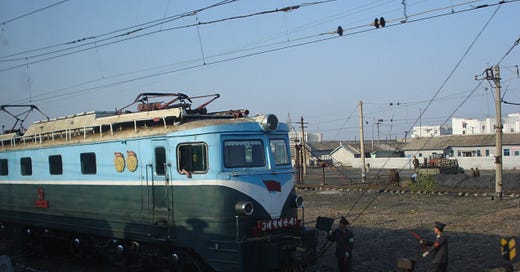North Korea’s Dangerous New Russia Ties
Kim seeks new high-tech devices in swap for Soviet-era arms to pound Ukraine
By: Shim Jae Hoon
Confirmation by officials in Seoul and Washington of reports that North Koreans are loading up hundreds of containers with arms and ammunition for transport by rail via Russia to Ukraine is an indication that Pyongyang is pursuing a dangerous new security partnership with Moscow, courting its Cold War ally with a massive supply of Soviet-era arms for Russia’s war of aggression in Ukraine hopefully in trade for newer, more lethal contrivances
Given China’s competitive position on its troublesome neighbor, however, it remains to be seen how far the North’s enthusiasm could go.
North Korea shares a short, 17.2km border with the Russian far east. Some of these cargoes have already reached Russian combatants in Ukraine, reports say, and are being fired at Ukrainians. A New York Times report said recently that these containers numbered as many as a thousand pieces, filled up, according to some reports here, with 240-mm rockets and 155-mm artillery shells.
It isn’t clear yet which side – whether it’s North Korea or Russia – that initiated these massive scale arms transfers. Whatever the background, the truth is that Russia is badly in need of conventional, Soviet-era artillery pieces and shells, while North Korea happens to be the only country that still has an ample stock of Soviet-era arms. Apart from its rudimentary nuclear weapons, which it has developed itself, North Korea today happens to be the world’s most heavily armed country, with ample stocks of Soviet-era conventional weapons.
Speedy deliveries of these munitions have come in the wake of a series of high-level meetings between top North Korean and Russian officials. Russian defense minister Sergei Shoigu met with North Korean leader Kim Jong Un in Pyongyang in July, where he was given a rare tour of North Korean defense facilities and munitions industry capability.
Then for five days in September, Kim Jong Un himself led a big government delegation including foreign and defense ministers for a comprehensive tour of Russian defense industry sites. He received a guided tour of Vostochnyi Aerodrome and the nuclear submarine base at Vladivostok. Kim showed special interest in acquiring Mig-3L fighters, Russian strategic bombers, and technology for launching reconnaissance missiles.
Neither side issued any statement as to what was discussed at the Kim-Putin summit that followed, showing that the Russian side remains cautious about its intent. In Seoul and elsewhere, Russian caginess has prompted analysts to wonder if Putin’s personal tour for Kim amounted to a show aimed at Seoul, which is helping to build up Poland’s defense industry. Some analysts opined that Putin’s personal guidance during Kim’s observation tour amounted to an indirect warning to Seoul to stay away from Poland and other eastern Europe close to Ukraine’s borders.
Depending on Russia’s options, beefing up North Korea’s armament industry could pose a direct threat to South Korea. Kim’s tour has thus alarmed South Korean officials. “If Russia hands over any of these high-tech items to North Korea,” said government party legislator Tae Yong Ho, indicating nuclear submarines and reconnaissance satellites, “that could undoubtedly mean a game-changer.” Tae ought to know. He was formerly a North Korean diplomat posted to London before his defection.
While the acquisition of these state-of-the-art weapons is clearly on the wish list of Kim’s entourage, it is by no means certain if Moscow is prepared to strike a deal. Neither side issued any statement following the Kim-Putin summit on September 13. Is it going to be a military procurement or aid package? This plus other potential alliance issues could come up for talks during Putin’s imminent visit to Pyongyang. Russian foreign minister Sergei Lavrov arrived in Pyongyang in the third week of October for preparation for Putin’s visit.
One problem hanging over the potential arms deal has to do with Russia’s support of North Korea’s insignificant economy, which not long ago forced Moscow to write off and forgive hundreds of millions of US dollars worth of Soviet-era loans. Today, with the Russian economy itself being under a tight spot owing to the Ukraine invasion, Moscow is hardly in a position to be generous with high-tech military aid for which it has invested huge budgets. According to one expert knowledgeable on Russia’s relations with North Korea, Russia holds a low opinion of North Korea’s ethical standards when it comes to using foreign technology, prompting concern that North Korea could use Russian weapons technology for reexport to Iran or other Middle East trouble spots.
Putin is well aware that North Korea is a broken country whose chief exports to Russia today consist mostly of construction laborers whose meager paychecks are cycled back to Pyongyang to pay for oil and food. China remains the main source of food aid and some foreign exchanges to help keep the regime afloat. But China is also wary, sharing a relatively long border of 1,500-km with the North, which often defies Beijing’s warnings and continues with its underground nuclear tests close to its border.
During the Sino-Soviet ideological disputes of the 1970s, Beijing kept a sharp watch over North Korea’s diplomatic alignment, making sure Pyongyang didn’t tilt towards Moscow. Today, it keeps a close watch on Kim’s arms shopping tours so that it will not fully tilt towards Russia. China, running a heavy trade volume with South Korea, has to keep a balance in its relations with Pyongyang to make sure it doesn’t deviate from the middle course. That could be a restraining factor on North Korea’s enthusiasm for new Russian high-tech weapons.
Shim Jae Hoon, a senior correspondent for the now-defunct Far Eastern Economic Review, is a regular contributor to Asia Sentinel



